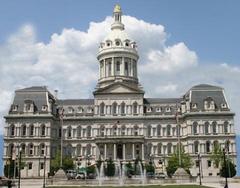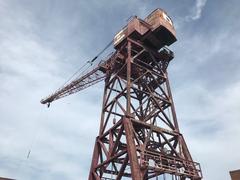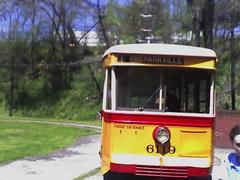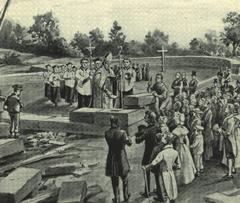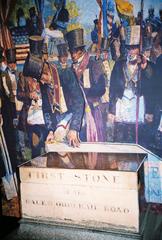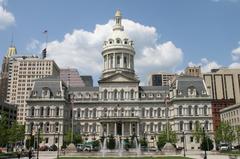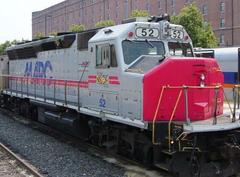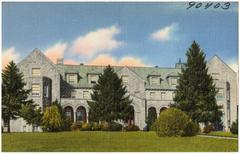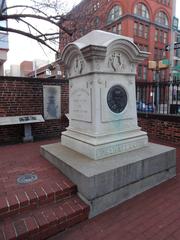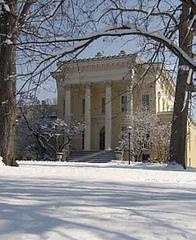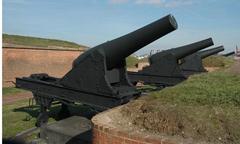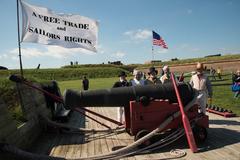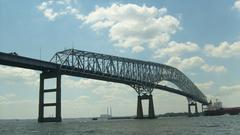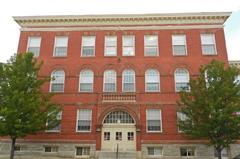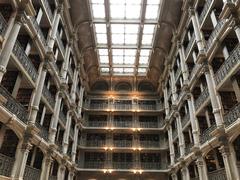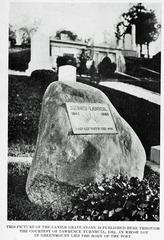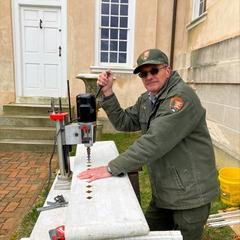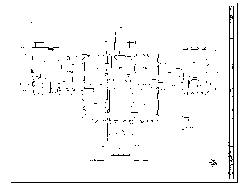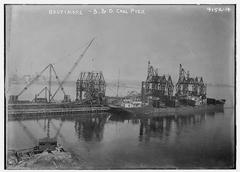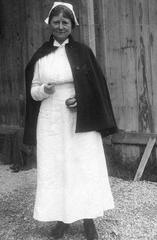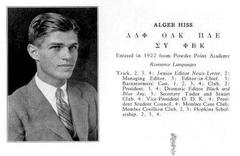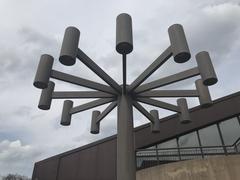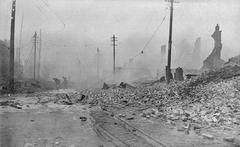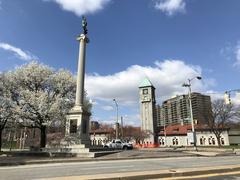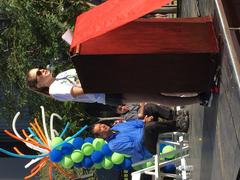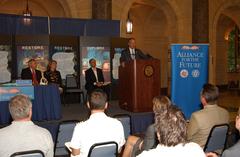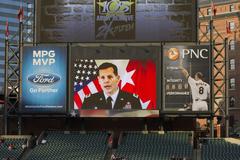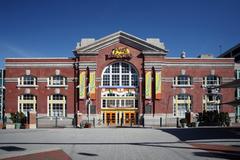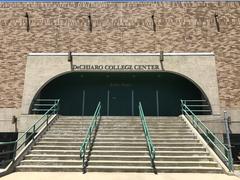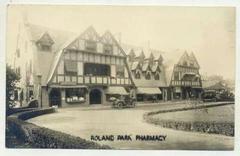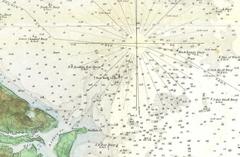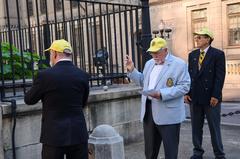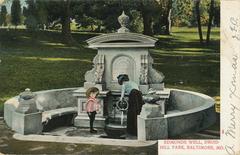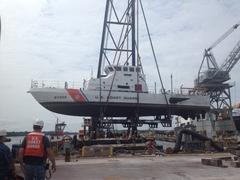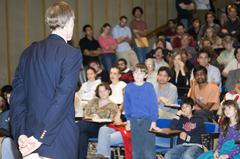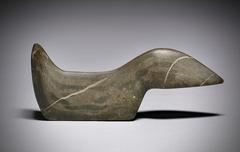
Battle Monument Baltimore: Visiting Hours, Tickets, and Historical Sites Guide
Date: 04/07/2025
Introduction to Battle Monument Baltimore
Standing proudly in the heart of downtown Baltimore, the Battle Monument is a powerful testament to American resilience, collective sacrifice, and civic identity. Erected between 1815 and 1827, this iconic structure commemorates the defenders of Baltimore during the pivotal Battle of Baltimore in the War of 1812—a moment that not only safeguarded the city but also inspired the writing of “The Star-Spangled Banner” (Baltimore Heritage; SAH Archipedia). Designed by Maximilian Godefroy, the monument’s unique blend of Egyptian Revival and neoclassical elements, along with its egalitarian commemoration of the fallen, marks it as a pioneering American memorial.
More than a war memorial, the Battle Monument is deeply woven into Baltimore’s urban fabric, appearing on the city’s seal and flag and serving as a focal point for civic ceremonies. Its accessible location and free admission invite visitors of all backgrounds to explore its rich history, symbolic artistry, and enduring legacy (Maryland Center for History and Culture). This comprehensive guide covers the monument’s origins, design, visitor information, nearby attractions, and practical travel tips to help you make the most of your visit.
Table of Contents
- Origins and Purpose of the Battle Monument
- Architectural Design and Symbolism
- Visiting Hours, Tickets, and Accessibility
- Nearby Attractions and Travel Tips
- The Monument’s Role in Baltimore’s Civic Identity
- Artistic and Historical Legacy
- Restoration and Preservation
- Frequently Asked Questions (FAQ)
- Visuals and Interactive Resources
- Summary and Visitor Tips
- References and Further Reading
Origins and Purpose of the Battle Monument
The Battle Monument stands as one of the earliest and most significant public war memorials in the United States. Its construction began on September 12, 1815, marking the first anniversary of the successful defense of Baltimore during the War of 1812 (explore.baltimoreheritage.org). The monument honors those who defended the city during the Battle of Baltimore—including the bombardment of Fort McHenry and the land engagement at North Point—which preserved American sovereignty and inspired Francis Scott Key’s “The Star-Spangled Banner” (alexandratravel.com). The monument’s purpose is to pay tribute to these defenders, memorializing their courage and sacrifice for generations to come (wikipedia.org).
Architectural Design and Symbolism
Egyptian Revival Base
Maximilian Godefroy’s innovative design introduced the Egyptian Revival style to the United States. The monument’s base, inspired by an Egyptian sarcophagus, rests on 18 layers of marble, each representing a state in the Union at the time (chap.baltimorecity.gov; explore.baltimoreheritage.org).
Roman Fasces Column
Rising from the base, the column resembles a Roman fasces—a bundle of rods bound together—symbolizing unity and collective strength. The cords binding the fasces are inscribed with the names of the fallen defenders, reflecting democratic values and the importance of shared sacrifice (chap.baltimorecity.gov).
Lady Baltimore
Crowning the monument is “Lady Baltimore,” an eight-foot-tall statue carved from Carrara marble by Antonio Capellano. She wears a victory crown, holds a laurel wreath in her raised hand, and a ship’s rudder in her lowered hand—symbolizing glory and the city’s maritime heritage. Facing the harbor, she is a constant reminder of Baltimore’s enduring spirit (chap.baltimorecity.gov).
Visiting Hours, Tickets, and Accessibility
- Location: Battle Monument Square, 101 N. Calvert Street, Baltimore, MD 21202 (wikipedia.org)
- Visiting Hours: The monument and square are open daily from dawn to dusk or generally from 8:00 AM to 8:00 PM, though hours may vary with the season.
- Admission: Free—no tickets required.
- Accessibility: The site features paved walkways and is wheelchair accessible.
- Guided Tours: Periodically available through local organizations like Baltimore Heritage; also included in many city walking tours.
- Special Events: Commemorative ceremonies, such as Defenders’ Day and War of 1812 anniversaries, are often held at the monument (NPS.gov).
Nearby Attractions and Travel Tips
- Fort McHenry National Monument: Site of the famous battle and inspiration for “The Star-Spangled Banner.”
- Inner Harbor: Home to museums, restaurants, and shops.
- Walters Art Museum and Mount Vernon Place: Explore more of Baltimore’s cultural and architectural heritage.
- Star-Spangled Banner Flag House: Where Mary Pickersgill sewed the flag that inspired the national anthem (Flag House).
- Travel Tips: Use public transit for easy access; wear comfortable shoes and bring water, especially in warmer months. The area is safe and walkable during daylight hours (Wolters World).
The Monument’s Role in Baltimore’s Civic Identity
The Battle Monument is a vital symbol of Baltimore’s civic pride and historical consciousness. Adopted as the official emblem of the city, it appears on Baltimore’s seal and flag. President John Quincy Adams’ 1827 toast to Baltimore as “the Monumental City” cemented its status as a civic icon (explore.baltimoreheritage.org). Its democratic ethos—inscribing the names of all fallen defenders, regardless of rank—was innovative and reflected the ideals of the early republic (Maryland Center for History and Culture).
Artistic and Historical Legacy
Antonio Capellano’s sculptures, including Lady Baltimore and the monument’s griffins, are among the nation’s oldest surviving monumental artworks (chap.baltimorecity.gov). The Battle Monument’s design and iconography set the standard for future American memorials and influenced the construction of subsequent public monuments (SAH Archipedia). Its unique blend of Egyptian and neoclassical motifs continues to be studied by architects and historians.
Restoration and Preservation
The monument has undergone several restoration projects to maintain its structural and artistic integrity. Major conservation efforts in 2011 prepared the monument for the War of 1812 bicentennial (chap.baltimorecity.gov). In 2013, the original Lady Baltimore statue was moved indoors to the Maryland Historical Society for preservation, replaced on the column by a replica (wikipedia.org). Ongoing restoration ensures the monument remains a vital part of Baltimore’s heritage.
Frequently Asked Questions (FAQ)
Q: What are the Battle Monument Baltimore visiting hours?
A: The square is open daily from dawn to dusk, generally 8:00 AM to 8:00 PM, but may vary seasonally.
Q: Is admission free?
A: Yes, the site is always free and does not require tickets.
Q: Is the site wheelchair accessible?
A: Yes, paved walkways and ramps make the monument accessible.
Q: Are guided tours available?
A: Yes, check with local organizations like Baltimore Heritage or city walking tour operators.
Q: What are nearby attractions?
A: Fort McHenry, Inner Harbor, Walters Art Museum, and the Star-Spangled Banner Flag House.
Visuals and Interactive Resources
- [High-quality image of Battle Monument Baltimore with alt text: “Battle Monument Baltimore - historic War of 1812 memorial”]
- [Map of downtown Baltimore marking the monument’s location]
- [Virtual tour links and multimedia resources (when available)]
Summary and Visitor Tips for Battle Monument Baltimore
The Battle Monument stands as a living symbol of Baltimore’s resilience, unity, and civic pride. Its innovative design, free public access, and central location make it an essential stop for anyone exploring Baltimore’s history (SAH Archipedia). Restoration efforts ensure its stories and artistry endure for future generations (Maryland Center for History and Culture). Pair your visit with nearby historical and cultural attractions for a comprehensive Baltimore experience (Battlefields.org).
Visitor Tips:
- Arrive early or late for the best lighting and a quieter atmosphere.
- Combine your visit with a walk to nearby museums and historic sites.
- Follow local heritage organizations for updates on events and tours (Baltimore Heritage).
References and Further Reading
- Battle Monument, Wikipedia
- Battle Monument Restoration, Baltimore Commission for Historical and Architectural Preservation
- Behind the Scenes Tour of Baltimore’s Battle Monument, Baltimore Heritage
- Battle Monument Baltimore Resources, Maryland Center for History and Culture
- Tour of War of 1812 Baltimore, American Battlefield Trust
- Baltimore and North Point History, National Park Service
- Exploring Baltimore’s Battle Monument, Route1Views
- 25 Best Things to Do in Baltimore - Ultimate 2025 Guide, Alexandra Travel
- Baltimore Tourism Official Site, Explore Baltimore Heritage



















